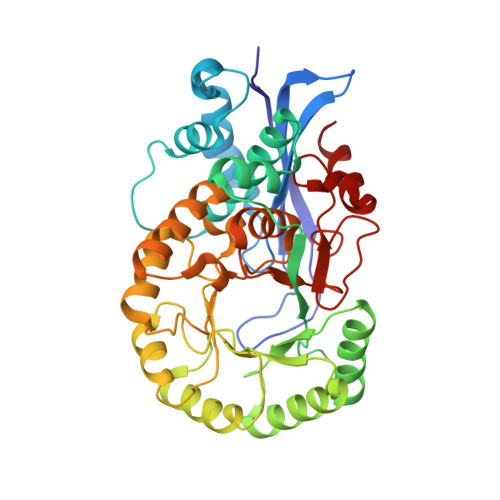Evolution of Enzymatic Activities in the Enolase Superfamily: d-Tartrate Dehydratase from Bradyrhizobium japonicum
Yew, W.S., Fedorov, A.A., Fedorov, E.V., Wood, B.M., Almo, S.C., Gerlt, J.A.(2006) Biochemistry 45: 14598-14608
- PubMed: 17144653
- DOI: https://doi.org/10.1021/bi061688g
- Primary Citation of Related Structures:
2DW6, 2DW7 - PubMed Abstract:
We focus on the assignment of function to and elucidation of structure-function relationships for a member of the mechanistically diverse enolase superfamily encoded by the Bradyrhizobium japonicum genome (bll6730; GI:27381841). As suggested by sequence alignments, the active site contains the same functional groups found in the active site of mandelate racemase (MR) that catalyzes a 1,1-proton transfer reaction: two acid/base catalysts, Lys 184 at the end of the second beta-strand, and a His 322-Asp 292 dyad at the ends of the seventh and sixth beta-strands, respectively, as well as ligands for an essential Mg2+, Asp 213, Glu 239, and Glu 265 at the ends of the third, fourth, and fifth beta-strands, respectively. We screened a library of 46 acid sugars and discovered that only d-tartrate is dehydrated, yielding oxaloacetate as product. The kinetic constants (kcat = 7.3 s(-1); kcat/KM = 8.5 x 10(4) M(-1) s(-1)) are consistent with assignment of the d-tartrate dehydratase (TarD) function. The kinetic phenotypes of mutants as well as the structures of liganded complexes are consistent with a mechanism in which Lys 184 initiates the reaction by abstraction of the alpha-proton to generate a Mg2+-stabilized enediolate intermediate, and the vinylogous beta-elimination of the 3-OH group is general acid-catalyzed by the His 322, accomplishing the anti-elimination of water. The replacement of the leaving group by solvent-derived hydrogen is stereorandom, suggesting that the enol tautomer of oxaloacetate is the product; this expectation was confirmed by its observation by 1H NMR spectroscopy. Thus, the TarD-catalyzed reaction is a "simple" extension of the two-step reaction catalyzed by MR: base-catalyzed proton abstraction to generate a Mg2+-stabilized enediolate intermediate followed by acid-catalyzed decomposition of that intermediate to yield the product.
Organizational Affiliation:
Department of Biochemistry, University of Illinois at Urbana-Champaign, 600 South Mathews Avenue, Urbana, Illinois 61801, USA.

















